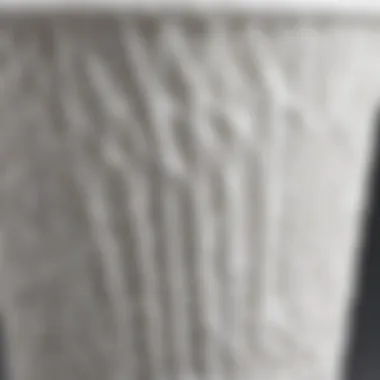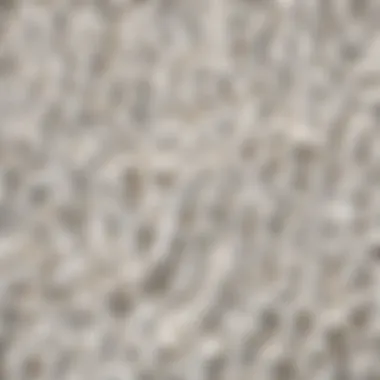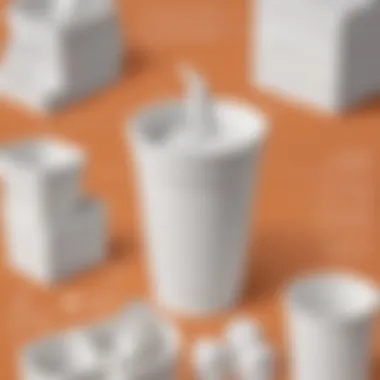Understanding Styrofoam Cups: Material and Impact Analysis


Intro
Styrofoam cups, commonly seen across cafes, workplaces, and homes, provoke thoughts beyond their basic function. Understanding these items means delving into multiple layers of their existence. Such investigation involves their materials, functions, and strikingy the environmental challenges they propose. By laying bare the fascinating science intertwined with these everyday objects, we equip ourselves and the next generation with knowledge to foster environmental responsibility.
Science Fun Facts
Styrofoam cups may appear ordinary, yet they hide intriguing facts worth exploring. These facts could spark curiosity in younger minds and inspire critical thinking about science.
- A Favorite in Safety: Did you know that Styrofoam, officially known as polystyrene, has incredible insulating properties? This is why it’s often used in shipping temperatures-sensitive items.
- Light Yet Strong: Styrofoam is incredibly lightweight. In fact, it is approximately 90% air, giving it striking strength without adding much weight.
- Recycling Dilemma: Many people don’t realize that recycling Styrofoam is difficult. Out of the vast collections of recyclables, only a small fraction of Polystyrene ever gets new life.
“Styrofoam takes hundreds of years to decompose, which raises significant environmental concerns.”
This highlights the importance of understanding rather than merely discarding.
Discover the Wonders of Science
Exploring facts is just a starting point. The broader implications open up various concepts patiently waiting for discussion.
- Scientific Concepts: The way Styrofoam is made aligns with many physics principles, especially in chemistry. It is essential to understand these connections.
- Educational Videos: Platforms like YouTube host a variety of videos that help visualize Styrofoam's interaction in real-life applications, offering better grasp of the underlying science.
- Interactive Learning: Engaging kids through hands-on demonstrations can solidify understanding. Why not try making a simple homemade model using recycling cases?
Considerations on Environmental Impact
It's crucial that families recognize the stance of Styrofoam in relation to current environmental trends and facts. Every individual decision can generate change. Together, parents and children can explore how choices influence sustainability.
Engaging young minds in these discussions encourages environmental stewardship while aiding comprehension of impactful issues. Whether choosing reusable materials or considering biodegradable options, knowledge is the critical foundation for promoting responsible choices.
Epilogue
In proceeding, we shall explore the overall materials associated with Styrofoam cups, their benefits, and the significant obstacles related with their use. A careful combination of theoretical information and practical examples will set the exploration stage, letting us articulate a clearer focus on why all of this for when it comes to cups matters.
Prolusion to Styrofoam Cups
The topic of Styrofoam cups merits attention for multiple reasons. First, the pervasive use of these cups in everyday life raises important considerations about their impact on the environment. Understanding Styrofoam is not just about materials; it encompasses the conversation around sustainability and consumer habits. For educators and parents, delving into this subject provides an opportunity to explore chemistry and environmental science through relatable examples. Products made from Styrofoam fill our cafes, workplaces, and schools, thus making it essential to comprehend their properties, advantages, and criticisms.
What is Styrofoam?
Styrofoam, a trademarked brand name, often refers to a material known theoretically as expanded polystyrene (EPS). This material is created from the polymerization of styrene, a compound derived from petroleum. When expanded, polystyrene forms a lightweight, yet firm structure, which generates a product that is suitable for a collection of uses, particularly as disposable food containers.
Styrofoam cups are widely recognized for their role in both hot and cold beverage service due to their thermal insulation properties. They offer an effective barrier against temperature, keeping drinks warm for extended periods. Moreover, their lightweight nature makes them convenient for carrying, thus they appear in many attended events, public functions, and spontaneous gatherings.
Historical Background
The history surrounding the origin of Styrofoam finds roots in 1941 when it was developed by the Dow Chemical Company. Originally conceived as insulation materials for building structures, it only became suitable for food and beverage packaging decades later. Its rise in popularity paralleled the fast-paced consumer culture from the mid-20th century onward.
In addition to insulation applications, the convenient aspect of Styrofoam for food service soon caught the attention of various industries. In the 1960s and 1970s, suppliers and establishments began to adapt these cups for disposable efficiency. Trust in disposable commodities increased, making Styrofoam cups a customizable option thanks to their ability to be produced in countless shapes and sizes. Today, they are ingrained in popular culture due to their perceived utility and ease of use.
Composition of Styrofoam Cups
Understanding the composition of Styrofoam cups is vital as it reveals the intricate details about this widely used material. Knowing how Styrofoam is constructed can help us make informed decisions. It impacts its benefits as well as environmental considerations. Engaging with the scientific components of Styrofoam fosters deeper questioning about environmental responsibility and product use.
Chemical Structure
Chemically, Styrofoam primarily consists of polystyrene. It is a type of polymer made up of long chains of repeating units known as monomers. This chemical structure gives Styrofoam its notable characteristics, including lightweight and insulating properties. The versatility of polystyrene allows it to be used in multiple applications beyond just cups. Understanding polystyrene is key to comprehending the physical traits of Styrofoam products that people interact with daily.
Manufacturing Process


The manufacturing of Styrofoam cups involves two key processes: polymerization and expansion. Both methods are central to forming the lightweight and insulative nature of Styrofoam cups, which contribute to its widespread usage.
Polymerization
Polymerization is a crucial process that transforms small molecules, called monomers, into larger polymer chains. In the case of Styrofoam, this involves the transformation of styrene, a liquid hydrocarbon, into solid polystyrene. One key characteristic of polymerization is that it enhances plasticity, giving the material both flexibility and toughness. This is a valuable property. Indeed, the ruggedness of styrene-made products stands out in the industry.
On the other hand, it’s worth mentioning that polymerization can produce byproducts that carry some environmental concerns. Understanding its impact can facilitate a greater sense of responsibility when choosing products made from polystyrene. The approach of polymerization supports the consumption and utility of Styrofoam but poses necessary challenges to address recognizing innovative recycling solutions.
Expansion
Expansion complements polymerization by introducing air into the polystyrene. This specific aspect of the manufacturing process transforms solid polystyrene into a foam-like product: Styrofoam. The expansion grants the material distinctive insulation properties. This quality makes it preferred for both food service and packaging due to its ability to tolerate heat.
A notable characteristic of the expansion process is that it makes the product lighter without sacrificing strength. This contributes to ease of use and handling. However, the expansion concept carries implications surrounding waste management as well. Managing such materials requires innovative sustainable solutions to reduce the environmental footprint.
Overall, a Sound understanding of these processes leads to more informed choices towards ecological repercussions and selective alternatives in today’s environment.
Benefits of Using Styrofoam Cups
Styrofoam cups are commonplace in various settings—from coffee shops to educational events. These cups offer several advantages that add to their popularity. Understanding these benefits gives insight into why they remain in use despite environmental concerns. While many users may appreciate their convenience, the underlying factors contribute significantly to their sustained reliance in both the food industry and everyday life.
Lightweight and Durable
One striking feature of Styrofoam cups is their lightweight nature. This characteristic greatly contributes to their ease of handling and transportation. When serving beverages at events or parties, the less weight translates to lower shipping costs and easier management. The sturdiness of Styrofoam also ensures that the cups do not crack or break during regular handling, making them ideal for busy environments.
- Impact during events: Using these lightweight cups means less strain on vendors and hosts when serving drinks.
- Convenience: Especially useful during outdoor activities where many cups need to be carried and transported.
Insulation Properties
Another notable attribute is their insulation capability. Styrofoam cups can maintain beverage temperatures effectively, keeping drinks hot or cold for a longer duration. This is essential for enjoying your coffee or iced tea without immediately losing the intended temperature. The unique chemical structure helps in creating a barrier to transfer heat, making personal enjoyment and user experience heightened.
Key benefits of insulation include:
- Keeping hot drinks warm longer help the drinkers enjoy the steaming beverages.
- Cold drinks remain refreshing, making it suitable for hot weather.
Cost-Effectiveness
To elaborate, Styrofoam cups tend to be economical compared to ceramic, glass, or paper alternatives. They are manufactured inexpensively and can be produced in bulk, which reduces overall expenses for businesses. Customers face lower prices too, making these cups appealing to many.
- Affordability: Small vendors benefit more, allowing them to offer customers refreshments without straining their budgets.
- Minimal waste and expense: Even if disposed of after single use, they represent less cost as opposed to items that require cleaning.
In summary, requiring less financial input and providing exceptional utility, Styrofoam cups remain a favored choice.
The benefits associated with Styrofoam cups underscore their role in various sectors, emphasizing their contributions to convenience, user experience, and cost management. However, acknowledging these advantages leads to a bigger consideration of alternatives and improvements in usage practices for a sustainable future.
Common Uses of Styrofoam Cups
Styrofoam cups have a distinct place in various sectors due to their unique properties. Understanding these common uses aids in recognizing why they remain popular despite their environmental drawbacks. This section dives into two main areas: food service and scientific applications, showcasing their practicality and versatility in real-world settings.
In Food Service
The food service industry is a significant user of Styrofoam cups. These cups are lightweight yet durable, making them ideal for quick-service restaurants and cafes. Their affordability is another attractive feature, particularly for businesses focusing on cost efficiency. Lightweight construction means extra savings on shipping and storage. Many establishments choose them for on-the-go beverages, from coffee to iced drinks. This efficiency caters to our fast-paced lifestyles.
Furthermore, Styrofoam offers effective insulation. It keeps hot beverages hot and cold drinks cold, which enhances customer experience. Like coffee shops, often use these cups to serve drinks without extra packaging. They also can be stacked easily, helping in handling and saving space. However, restaurants must consider the environmental implications of these cups. The balanced assessment between convenience and responsibility is key.
In Scientific Applications
In scientific contexts, Styrofoam cups find numerous applications, particularly in educational settings. Teachers sometimes use them for experiments, such as examining temperature changes. Their insulation properties can sometimes provide hands-on learning experiences. The simplicity of a Styrofoam cup makes it approachable for elementary school children studying basic scientific principles.


Moreover, there's a trend to utilize these cups for simple models and prototyping in various scientific experiments due to their customizable form. They can be cut, painted, or combined with other materials for different scientific illustrations. However, educators must discuss the potential environmental footprint of these materials while encouraging innovation.
Understanding both benefits and ecological drawbacks makes science engaging.
Environmental Concerns
Environmental concerns surrounding Styrofoam cups have provoked considerable debate in recent years. While the material serves its purpose and offers advantages like insulation and lightweight properties, these benefits must be weighed against its impact on the environment. Understanding the drawbacks helps inform choices for a more sustainable future.
Non-Biodegradability
One major environmental issue with Styrofoam cups is their non-biodegradability. Styrofoam, also known as expanded polystyrene, does not decompose through natural processes. This persists in landfills for hundreds of years. As communities grow and consumer habits change, the reliance on single-use products leads to increased waste. Over time, this contributes to filling up landfill spaces and occupying them for unnecessary periods.
Efforts have been made to minimize this problem, but alternatives to Styrofoam still require broad awareness and acceptance. Promoting education on this topic can lead to meaningful behavioral changes.
Impact on Wildlife
The impact of Styrofoam on wildlife cannot be overlooked. Animals can mistake pieces of Styrofoam for food. This ingestion can lead to serious health complications or death. Sea creatures like turtles often encounter Styrofoam in the oceans where it can accumulate due to improper disposal.
Here are several threat made evident by Styrofoam waste within ecosystems:
- Ingestion: Creatures consuming Styrofoam may suffer internal damage or starvation because their digestive systems can be filled with non-nutritive matter.
- Entanglement: Larger pieces can entangle entrap wildlife, leading to presumed drowning or reduced mobility.
This situation underlines the importance of replacing Styrofoam with more wildlife-friendly alternatives to promote a healthier ecosystem.
Pollution Issues
Pollution created through the production and disposal of Styrofoam cups leads to a variety of broader environmental issues. The manufacturing process emits volatile organic compounds (VOCs) and encourages the formation of non-biodegradable waste materials.
Furthermore, discarded Styrofoam can break into smaller pieces, contributing to macroplastics in water sources. These microplastics may then enter food chains, creating a cycle of harm not just to original producers, but also potentially affecting human health.
Efforts to raise awareness and solidify legislation targeting pollution due to Styrofoam are critical. Local communities must encourage recycling practices or the use of compostable or reusable options.
Addressing these environmental issues is essential for protecting the planet's health and the diverse life it supports.
The ongoing dialogue regarding Styrofoam’s ecological ramifications is pivotal. Those who consume products made from this material must remain informed. Awareness can drive demand for more sustainable options, allowing consumers to take critical steps towards reducing their carbon footprint.
Alternatives to Styrofoam Cups
Styrofoam cups have dominated the food and beverage industry for decades due to their low cost and convenience. However, growing environmental concerns have prompted many to seek viable alternatives. Understanding these options is crucial for any environmentally conscious individual or educator.
Compostable Materials
Compostable materials represent one promising alternative to traditional Styrofoam cups. These materials break down naturally in compost settings, returning nutrients to the soil. Components in these cups often include plant-based fibers, which decompose much more quickly than Styrofoam.
Benefits of using compostable materials include:
- Reduced Environmental Impact: They mitigate landfill waste by decomposing fully. This process emits fewer greenhouse gases than Styrofoam.
- Health Safety: Many compostable options do not leach harmful chemicals into food or beverages.
- Biodegradable Options: Most compostable cups can break down within a few months, depending on conditions.
However, there are some considerations. Compostable cups require specific conditions to degrade efficiently. They should not be tossed into regular waste but rather compost bins for proper breakdown. Accessibility of composting facilities can sometimes pose a challenge in urban areas. Educating users about these requirements is vital.
This emphasizes the importance of educating individuals about effective compost setups and procedures. Without proper understanding, even high-quality compostable materials may end up in landfills.
Reusable Cups
Reusable cups offer another efficient alternative to one-time-use Styrofoam cups. Unlike disposable options, reusable mugs and cups promote sustainability and reduce waste significantly. They come in various materials, including stainless steel, glass, or BPA-free plastic.
The advantage of using reusable cups includes:


- Cost-Effectiveness: Although reusable cups may have a higher upfront cost, repeated use leads to savings over time. Businesses can save money by reducing their reliance on disposable cups.
- Variety and Customization: Reusable cups are available in many shapes, colors, and sizes. This allows for personalization and creativity.
- Encouraging a Greener Mindset: The use of reusable items encourages eco-friendly practices and heightened awareness of waste.
Yet, the transition to reusable cups is not without challenges. Some users may be inclined to forget their cups, leading to a return to disposables. Education campaigns promoting remembering reusable cups can encourage consistent usage. Initiatives such as deposit schemes may also incentivize individuals to use and return cups.
Compostable and reusable options present viable ways to limit the environmental impact of cup usage. The combined efforts to understand and encourage these alternatives can cultivate a culture of sustainability.
Regulatory Measures and Initiatives
Regulatory measures and initiatives play a critical role in managing the use of Styrofoam cups, given their environmental impact. A strong regulatory framework ensures that the dissadvantage of this material is addressed adequately. It is important to be informed about the legislative actions while knowing the industry standards in place. This understanding can guide consumer choices and the responsible production of materials.
Legislative Actions
Legislative actions are significant in addressing the widespread implications of Styrofoam cups. Many cities and regions have introduced bans or levies on single-use plastic products, including Styrofoam. These laws emphasize reducing waste and promoting sustainable alternatives.
For example, countries like Canada, and a few states in the US such as California and New York, have already set up strict regulations against the sale of Styrofoam containers. This awareness can significantly drive the adoption of greener options by both businesses and consumers. Additionally, public education campaigns support these procedures and explain benefits of the transition, increasing community responsibility toward waste management.
Key elements of legislative measures include:
- Prohibition policies: Banning the production and distribution of Styrofoam cups in the local area.
- Tax incentive programs: Encouraging businesses to switch to eco-friendly product lines.
- Funding for innovation: Supporting research into alternative materials through government grants.
Industry Standards
Industry standards are another pillar for regulating Styrofoam products. They provide a set of benchmarks that companies must meet in their production processes in order to ensure safety and minimize environmental harm. Organizations like ASTM International and ISO outline clear guidelines for materials and their environmental safety.
Adhering to these standards involves making sure products are recyclable or made from recycled materials. The strict measurements can also govern the processes by which Styrofoam is produced.
Important industry standards to note are:
- Recycling Initiatives: Many recyclers accept only certain grades of Styrofoam. Knowledge of these grades can inform better purchasing choices.
- Sustainability Certifications: Certifications like LEED encourage businesses to choose materials that align with sustainability initiatives.
Educating Young Scientists
Understanding Styrofoam cups in educational contexts serves various important educational purposes. It exposes children to key environmental concerns while fostering scientific literacy. Incorporating practical science lessons can lead children to explore material science, chemistry, and ecology all through everyday objects like Styrofoam cups. This engagement is crucial for raising awareness about environmental challenges, which many young learners will face.
Introducing Styrofoam in Educational Settings
When introduing Styrofoam cups in the classroom, it's vital to emphasize both their benefits and their drawbacks. Ko kas that they are made of expanded polystyrene, and have become a ubiquitous material for many applications. Discussing their role in everyday life can make the topic zaidi relatable. These are also moments to filter through common misconceptions about materials and their environmental impacts.
Using Styrofoam in lessons can effectively link into larger important themes, such as recycling, pollution reduction, and resource conservations. Furthermore, teachers might create inter-class programs that involve discussions, Q&A sessions, or debates. All these aspects make σχεδόν all subjects interesting and vital for a deeper understanding.
Hands-On Experiments and Activities
Hands-on experience plays a significant role in learning. Simple activities can showcase different properties of Styrofoam cups, bringing physics and environment science to life. Here are some engaging experiment ideas:
- Thermal Insulation Test: Compare the insulation properties of Styrofoam cups with glass or paper cups. Pour equal quantities of hot water in each type of cup and observe the temperature after a set period. This simple activity can draw conversations around heat retention and why this matters.
- Water Transportation Experiment: Fill Styrofoam cups with water and cover them with different materials such as foil or plastic wraps. Challenge children to imped the maximum water amount that can be held and ask lessons on waterproofing and related scientifc principles.
- Building Structures: Organize groups that build the tallest structure possible using only Styrofoam cups. This can connect engineering concepts with team work while insights into real-world materials science emerges.
Engaging children in hands-on activities not only simplifies complex scientific ideas but also spurs their innate creativity.
Combining detailed discussions with these interactive experiments can lead to a richer educational experience. Allowing exchanges, questions, and ideas, children will hone their analytical skills while quiestioning the status quo regarding materials like Styrofoam cups. Overall, such activities can upgrade their learning, ensuring they grasp key principles about material behavior and environmental impact.
The End
In this concluding section, we reflect on the multifaceted nature of Styrofoam cups as explored throughout the article. Understanding their chemical properties, manufacturing techniques, benefits, and drawbacks reveals a more complex picture than simply viewing them as convenient disposable items. The discussion of Styrofoam cups holds significance not only in terms of environmental implications but also educates young minds about materials and sustainability.
Summary of Key Points
- Styrofoam cups are lightweight and provide excellent thermal insulation.
- They are routinely used in food service and scientific applications.
- The non-biodegradable nature poses pollution risks and impacts wildlife adversely.
- Alternatives, including compostable materials and reusable cups, are emerging in the market, providing a way to combat environmental damage.
- Regulatory measures are gaining traction, with legislative initiatives working towards reducing Styrofoam’s prevalence.
- Incorporating Styrofoam in educational settings inspires critical thinking about environmental stewardship among children.
Future Outlook
The future of Styrofoam cups remains uncertain. With increasing awareness regarding environmental issues such as littering and pollution, the public sentiment is shifting. Educational initiatives can empower future generations to grasp the scientific and socio-economic factors behind material choices.
Ongoing research and innovation will likely yield new alternatives to Styrofoam cups, enhancing sustainability and reducing waste. As consumers demand better, industries are pressured to adapt. In summary, awareness and educated choices will shape a brighter future regarding the use of all materials, including Styrofoam cups.







